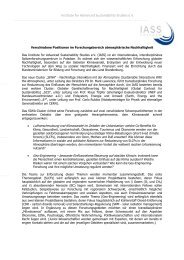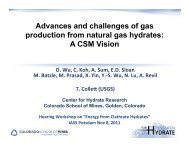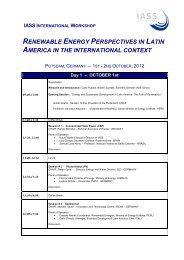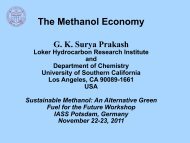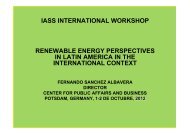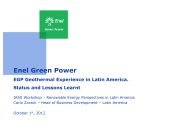Samuel Luna Abreu - IASS Potsdam
Samuel Luna Abreu - IASS Potsdam
Samuel Luna Abreu - IASS Potsdam
You also want an ePaper? Increase the reach of your titles
YUMPU automatically turns print PDFs into web optimized ePapers that Google loves.
CONCENTRATED SOLARPOWER IN BRAZILPOTENTIAL AND PERSPECTIVES<strong>Samuel</strong> <strong>Luna</strong> de <strong>Abreu</strong>Instituto Federal de Santa Catarina - Brazil
SUMMARY Socioeconomic data Energy sector overview Government incentive programs Potential for CSP First demonstration projects RemarksRenewable Energy Perspectives in Latin America in the International Context - <strong>IASS</strong>-<strong>Potsdam</strong> - 1-2 October 2012
SOCIOECONOMIC DATA Area - 8,514,876.6 km 2 (5 th ) Population - 193,946,886 (5 th ) GDP - euro 1.9 trillions (6 th ) GDP (per capita) - euro 9,700(53 rd ) HDI – 0.718 (84 th ) South and southeast are the mostdeveloped regions Santa Catarina (0,840) Florianópolis (0,875)HighMedium-highMedium-lowRenewable Energy Perspectives in Latin America in the International Context - <strong>IASS</strong>-<strong>Potsdam</strong> - 1-2 October 2012
ENERGY SECTOR OVERVIEWGeneration More than 2,000 power plants, totalizing over than 100,000 MW Around 50,000 MW in new plants (construction + consession) Consumption of 419 TWh in 2009 72% public and 28% private companies in the generation sector 10 companies are responsable by 67% of the generationTransmission: 5 companies have 74% of the market share (84% public)Distribution: 70% private companiesRenewable Energy Perspectives in Latin America in the International Context - <strong>IASS</strong>-<strong>Potsdam</strong> - 1-2 October 2012
ENERGY SECTOR OVERVIEWMore than 90 % of theconsumer units are in theinterconnected grid 64 million consumers (55million in the residentialsector)Source: ONS – National Electricity System Operator, 2011
ENERGY SECTOR OVERVIEWDomestic energy supply by sourcehydroimportsbiomasswindnatural gasoil productsnuclearcoal77%8.11%5.41%0.2%2.6%2.9%1.3%2.5%Electricity consumption per sector22.2%14.3%8.7%industrialresidentialcommercialpublicagriculturalenergytransportation46.7%4.2%3.6%0.3%Renewable Energy Perspectives in Latin America in the International Context - <strong>IASS</strong>-<strong>Potsdam</strong> - 1-2 October 2012
GOVERNMENT INCENTIVES - PROINFA“Programa de Incentivo às Fontes Alternativas de Energia Elétrica” (IncentiveProgram to Electricity Alternative Sources)Introduction of 3,300 MW from alternative sources: wind, biomass and smallhydro power plantsSolar energy was not an alternative in this programInvestments in this program were over than euro 5.1 billlionReduction of 2.8 billion ton of CO2 are expectedEstimated total capacity:Wind: 1,422.92 MWBiomass: 685,24 MWSmall Hydro: 1,191.24 MWRenewable Energy Perspectives in Latin America in the International Context - <strong>IASS</strong>-<strong>Potsdam</strong> - 1-2 October 2012
GOVERNMENT INCENTIVESLuz para Todos - “Light for all” Aims to deliver energy to morethe 12 million unattended people Euro 9,8 billion (euro 6.9 bi fromthe government – euro 3.4 bialready released)Renewable Energy Perspectives in Latin America in the International Context - <strong>IASS</strong>-<strong>Potsdam</strong> - 1-2 October 2012
GOVERNMENT INCENTIVES – PV for the next years Market growth is expected for the next years Strategic R&D program of the Brazilian Regulatory Agency for theElectric Energy sector – ANEEL 24 MW ~ R$ 400 mi (euro 153 mi) 18 utility companies RIO 2016 Olympic games + World Soccer Games Grid-connected systems Resolution n. 482; 17/april/2012 Net-metering Microgeneration -
GOVERNMENT INCENTIVES Solar Water Heating Economic feasibility is already acchieved Several cities adopted local laws that oblige theinstallations of solar systems in new residences. Some programs for low income families: Minha Casa, Minha Vida (My home, my life) – projects withsolar hot water systems are incentivated Efficiency program from the regulatory agency of theelectric program (ANEEL) allows the utility companies todonate the equipment for consumers that substituteelectric showers by solar systemsRenewable Energy Perspectives in Latin America in the International Context - <strong>IASS</strong>-<strong>Potsdam</strong> - 1-2 October 2012
CSP
eXtyles User Documentationstick (i.e. the fundamental equilibrium exchange rate) used to measure its undervaluation.Cheung et al. (2007) provides a brief review of some of those concepts and discussesthe difficulty in measuring the equilibrium exchange rate and the uncertaintysurrounding those measurements. [Footnote]Most analysts have concluded that the Chinese currency has been significantly undervalued.[Footnote_Continued]which gives this XML:2Whether a country's currency is undervalued depends on the concept of the yardstick(i.e. the fundamental equilibrium exchange rate) used to measure its undervaluation. Cheung et al. (2007) provides a brief review of some ofthose concepts and discusses the difficulty in measuring the equilibrium exchange rate andthe uncertainty surrounding those measurements.Most analysts have concluded that the Chinese currency has been significantly undervalued.3 One or more paragraphs of text, as well as one or more unnumbered tables (without a table caption)and/or one or more of a list of defined objects that might include lists and display equations. Thefirst text paragraph carries the appropriate footnote style, and any subsequent text paragraphscarry the “Footnote_Continued” style. Note that two lists would need to be separated by anotherparagraph(s) that did not carry a list style; otherwise, they would be combined into a single list (thisis true anywhere in the document).3. This can be shown if we derive the saving equation from a typical Keynesian consumptionequation, C = C 0 + αY, where C is consumption, C 0 is the subsistence consumption,Y is income, and α is the propensity to consume. The corresponding savingequation would be, implying that [Footnote][Display_Equation]Thus [Footnote_Continued][Display_Equation]the saving/income ratio is a positive function of income. [Footnote_Continued]which gives this XML:3This can be shown if we derive the saving equation from a typical Keynesian consumptionequation, ,where C is consumption, isthe subsistence consumption, Y is income, and is the propensity to consume. The correspondingsaving equation would be ,implying thatCopyright ©2013 Inera, Inc. All rights reserved. 12
ENERGY RESOURCE FOR SOLAR POWER Semiarid region Close to São FranciscoRiver Regions with yearlyenergy (DNI) over than2.2 MWh/m 2 in orangeRenewable Energy Perspectives in Latin America in the International Context - <strong>IASS</strong>-<strong>Potsdam</strong> - 1-2 October 2012
ENERGY RESOURCE FOR SOLAR POWERMain riversTransmission linesRenewable Energy Perspectives in Latin America in the International Context - <strong>IASS</strong>-<strong>Potsdam</strong> - 1-2 October 2012
PROPOSAL Develop in Brazil concentrated solar power generationtechnologies. Focus in the short term on the most promissing technologies forcommercial use. Phase I: Parabolic Troughs without thermal storage (1 MW). Phase II: Thermal storage system for the Phase I. Phase III: Other technologies: Central tower Linear Fresnel Parabolic dishes Concentrated PV Systems Systems for desalinization and detoxification of waterRenewable Energy Perspectives in Latin America in the International Context - <strong>IASS</strong>-<strong>Potsdam</strong> - 1-2 October 2012
SITE SELECTIONRenewable Energy Perspectives in Latin America in the International Context - <strong>IASS</strong>-<strong>Potsdam</strong> - 1-2 October 2012
SITE SELECTIONRenewable Energy Perspectives in Latin America in the International Context - <strong>IASS</strong>-<strong>Potsdam</strong> - 1-2 October 2012
SITE SELECTION45403530252015Global index1050PETROLINA (PE)JUAZEIRO (BA)Montes Claros (MG)Juazeiro do Norte (CE)BOM JESUS DA LAPA (BA)Irece (BA)Iguatu (CE)Espinosa (MG)Pirapora (MG)ARCO VERDE (PE)CABROBÓ (PE)Mossoro (RN)Carinhanha (BA)Remanso (BA)Monte Azul (MG)Picos (PI)TRIUNFO (PE)Apodi (RN)Morada Nova (CE)Paulistana (PI)BARRA (BA)Caetité (BA)Parnaiba (PI)Bom Jesus do Piaui (PI)MONTEIRO (PB)Cruzeta (RN)Florania (RN)FLORESTA (PE)Renewable Energy Perspectives in Latin America in the International Context - <strong>IASS</strong>-<strong>Potsdam</strong> - 1-2 October 2012
SITE SELECTION – Pontal Sul Irrigation ProjectVisitas On de site campo visits a PetrolinaIdentificationIdentifica ç ão de pontosof eligibleeleg í veispointsno s í tioinPontal SulPontal SulTotal associated costs(pavement, water andelectrical connection costs)+exclusion areasLand selection –Lot 01 (45 ha)CodevasfLot 01
SITE SELECTION – Pontal Sul Irrigation ProjectPV2.5 MWConnected tothe gridCSP Toweror Fresnel1MWPVNewtechnologiesCSPparabolictrough1MWfutureimprovement:3 hs storage9,45 ha
PROJECT HELIOTERM – CEPEL/ELETROBRAS Budget: Finep - R$ 18.0 mi (euro 6.9 mi) Pernambuco Government – R$ 5.0 mi (euro 1.9 mi) Cepel + UFPE - R$ 5.3 mi (euro 2.0 mi) TOTAL – R$ 28.3 mi (euro 10.8 mi) 36 months Approved by FINEP in 06.aug.2012.Renewable Energy Perspectives in Latin America in the International Context - <strong>IASS</strong>-<strong>Potsdam</strong> - 1-2 October 2012
BASIC CONFIGURATIONSolar fieldArea solar collector assembly (SCA) 828 m 2SCA per loop 4Number of loops 3Total aperture area 9,936 m 2 Heat transfer fluidTherminol VP1Power blockNominal Power1.2 MWP inlet40 barT inlet 375 °CP outlet0.1 barT outlet 46 °CRenewable Energy Perspectives in Latin America in the International Context - <strong>IASS</strong>-<strong>Potsdam</strong> - 1-2 October 2012
BASIC CONFIGURATIONLegend1. Land2. Solar field (phase II)3. Solar fiel (phase I)4. Power block5. Entrance6. Main road7. Water supply8. Irrigation channelPhase IIPhase I
OTHER INITIATIVESUFPE (Federal University of Pernambuco):Geographic informations system – GIS for 100 MWe power plants in the northeast semiaridregionsLinear Fresnel collector for process heatCEMIG (Minas Gerais state utility) + CEFET-MG (Federal Center for TechnologicalEducation)Parabolic trough prototypesDemonstration CSP with 2 MW.USP (University of São Paulo)Two demonstration CSP, central tower, 100 kW.Petrobras (Brazilian oil company)Cooperation with UFSC (Federal University of Santa Catarina); UFRN (Federal University ofRio Grande do Norte); and CTGás – ER (Technological Center for Gas and RenewableEnergies)Study for instalation of a 3 MWe CSP plant with central towerSimulation, capacity building, cost estimation and site locationRenewable Energy Perspectives in Latin America in the International Context - <strong>IASS</strong>-<strong>Potsdam</strong> - 1-2 October 2012
REMARKS During next years CSP technology in Brazil: Increase in interest Competition of PV technology Dominant technology is not yet stablished Important movements in Brazil; butperspectives for commercial power plants willonly appear after the instalation of the firstdemonstrations.Renewable Energy Perspectives in Latin America in the International Context - <strong>IASS</strong>-<strong>Potsdam</strong> - 1-2 October 2012
THANK YOU!Aknowledgements:Eduardo Torres Serra; Leonardo dos Santos Reis Vieira;Ana Paula Cardoso Guimarães – CEPEL/ELETROBRAS




